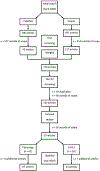Toxicology of flavoring- and cannabis-containing e-liquids used in electronic delivery systems
- PMID: 33746051
- PMCID: PMC8251682
- DOI: 10.1016/j.pharmthera.2021.107838
Toxicology of flavoring- and cannabis-containing e-liquids used in electronic delivery systems
Abstract
Electronic cigarettes (e-cigarettes) were introduced in the United States in 2007 and by 2014 they were the most popular tobacco product amongst youth and had overtaken use of regular tobacco cigarettes. E-cigarettes are used to aerosolize a liquid (e-liquid) that the user inhales. Flavorings in e-liquids is a primary reason for youth to initiate use of e-cigarettes. Evidence is growing in the scientific literature that inhalation of some flavorings is not without risk of harm. In this review, 67 original articles (primarily cellular in vitro) on the toxicity of flavored e-liquids were identified in the PubMed and Scopus databases and evaluated critically. At least 65 individual flavoring ingredients in e-liquids or aerosols from e-cigarettes induced toxicity in the respiratory tract, cardiovascular and circulatory systems, skeletal system, and skin. Cinnamaldehyde was most frequently reported to be cytotoxic, followed by vanillin, menthol, ethyl maltol, ethyl vanillin, benzaldehyde and linalool. Additionally, modern e-cigarettes can be modified to aerosolize cannabis as dried plant material or a concentrated extract. The U.S. experienced an outbreak of lung injuries, termed e-cigarette, or vaping, product use-associated lung injury (EVALI) that began in 2019; among 2,022 hospitalized patients who had data on substance use (as of January 14, 2020), 82% reported using a delta-9-tetrahydrocannabinol (main psychoactive component in cannabis) containing e-cigarette, or vaping, product. Our literature search identified 33 articles related to EVALI. Vitamin E acetate, a diluent and thickening agent in cannabis-based products, was strongly linked to the EVALI outbreak in epidemiologic and laboratory studies; however, e-liquid chemistry is highly complex, and more than one mechanism of lung injury, ingredient, or thermal breakdown product may be responsible for toxicity. More research is needed, particularly with regard to e-cigarettes (generation, power settings, etc.), e-liquids (composition, bulk or vaped form), modeled systems (cell type, culture type, and dosimetry metrics), biological monitoring, secondhand exposures and contact with residues that contain nicotine and flavorings, and causative agents and mechanisms of EVALI toxicity.
Keywords: Delta-9-tetrahydrocannabinol (Δ(9)-THC); Flavorings; Toxicity; Vaporizers; e-cigarettes; e-liquids.
Published by Elsevier Inc.
Conflict of interest statement
Conflict of Interest
The authors declare that there are no conflicts of interest.
Figures



References
-
- Acosta MF, Muralidharan P, Meenach SA, Hayes D, S MB, & Mansour HM (2016). In vitro pulmonary cell culture in pharmaceutical inhalation aerosol delivery: 2-D, 3-D, and in situ bioimpactor models. Current Pharmaceutical Design 22, 2522–2531. - PubMed
-
- Al-Saleh I, Elkhatib R, Al-Rajoudi T, Al-Qudaihi G, Manogarannogaran P, Eltabache C, … Almugbel S (2020). Cytotoxic and genotoxic effects of e-liquids and their potential associations with nicotine, menthol and phthalate esters. Chemosphere 249, 126153. - PubMed
-
- Apirakkan O, Frinculescu A, Denton H, Shine T, Cowan D, Abbate V, & Frascione N (2020). Isolation, detection and identification of synthetic cannabinoids in alternative formulations or dosage forms. Forensic Chemistry 18, 100227.
Publication types
MeSH terms
Substances
Grants and funding
LinkOut - more resources
Full Text Sources
Other Literature Sources
Medical

